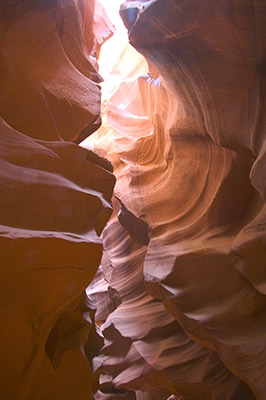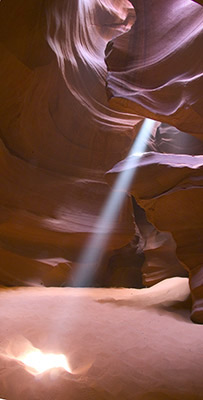
Gallery Photographers
Partner
Artists-in-Residence
Guest Online
Links
Read other articles of
Bill's Walkabout Journal
Send an email to Bill
Bill Bernbeck
Bio
Artist Statement Journal
Gallery
Walkabout Journal
Navajo Sandstorm
The wind was its own element. It came out of the northeast from the Colorado plateau, hurling sand and dust in its path. It pushed in unabated fury across the sandstone landscape of the Navajo Nation. Its cargo of unimaginable billions of sharp-edged grains hurled against everything in its path. Standing in the middle of it, my head buried as much as possible in my jacket, all I could think was “What am I doing here?”
I was at the brink of Antelope Canyon, one of the most spectacular natural wonders in the world. It is a photographer’s dream destination. For years, I have wanted to make my own pilgrimage here to see it and photograph it. I had no illusions that I would capture images any better than many others have already done. I just wanted to be here and gather something of my own work.
The only access into the canyon is with a licensed Navajo guide. I had arranged for a photographer’s guided tour several weeks before. The commitment was in place to see it through, rain or shine. I knew I would need luck to have favorable conditions. Now I am at the entrance to the canyon with a sandstorm bearing down mercilessly. Is it a point of no return? I gave myself no choice but to make the best of the situation.
One of the many challenges faced by outdoor photographers is to deal with the elements Nature sends our way. Rain, wind, and dust all present opposing environments to imperil the delicate (and expensive) equipment, as well as dampening one’s enthusiasm. Nevertheless, if you are going to capture the landscape, you are automatically working en plein air. Sometimes you get to pick the conditions, sometimes you do not.
That April day in Page, Arizona started out cool and partially cloudy, a slight breeze rustling the treetops in town. The waiting room for Antelope Canyon Tours was filled with people ready to go. Our photographer’s tour loaded into a large GM Suburban, and our assigned guide proceeded to warn us that the wind and sand at the canyon would be heavy. Be advised that cameras could be ruined under those conditions. I looked at the other two photographers, and watched them tuck their compact pocket shooters deeper into their jackets. My own comparatively anvil-sized SLR, along with auxiliary lenses, was inside my hydration backpack. The sand warning somehow made that pack suddenly weigh a ton. Bernie ran to our car and managed to find some plastic grocery bags to let me rig up something resembling protection, but I gulped in dismay at whatever feeble contraption I could possibly contrive.
There were about twenty people waiting for their noon tour to start. With five people in our photographer’s tour group, that left around fifteen people who were also going to be at the canyon at the same time. As we drove along the main street of Page, I noted at least three other touring agencies loading up with guests headed for the same location. There would be fifty or more people finding their way into that narrow canyon at about the same time. We would all be buffeted by the same sandstorm.
The wind and driven sand increased noticeably as we made our way out of town. The ride up the dry basin of Antelope Wash went well, the 4-wheeling SUV smoothly handling the seemingly bottomless sand and gravel. The wash is about a hundred yards wide, with sandy slopes holding an occasional dried out looking bush. The sides were high enough to hide any view of the surrounding terrain. I watched the blowing sand form streamlines down the length of the wash.
After about three miles, the wash ran into a
large face of rock. The rock tapered into a funnel that ended in
an impossibly narrow slit, the entrance to Upper Antelope
Canyon. The opening was just wide enough for one person to enter
or maybe two if both turned sideways. The time was around
11:30AM. Our photographer’s tour would give us three hours in
the canyon during what should be the most advantageous lighting
conditions. The mid day sun was valiantly trying to shine
through the dust cloud.
 Antelope
Canyon is as magnificent as many of the images have shown it to
be. Water and wind have carved a narrow slot through the
sandstone in a maze of swirls and convolutions. The rock was
sculptured in a hypnotic pattern of waves and curls. Small
patches of sky were visible only in a few places. It was
difficult to comprehend the depth with the smooth irregularities
of the worn rocks. After fifty yards, it emerged into another
wash upstream. The entire path was paved with soft sand.
Antelope
Canyon is as magnificent as many of the images have shown it to
be. Water and wind have carved a narrow slot through the
sandstone in a maze of swirls and convolutions. The rock was
sculptured in a hypnotic pattern of waves and curls. Small
patches of sky were visible only in a few places. It was
difficult to comprehend the depth with the smooth irregularities
of the worn rocks. After fifty yards, it emerged into another
wash upstream. The entire path was paved with soft sand.
My first impression was darkness. The canyon walls in front of me at noon on this early April day were a deep gray-red color, not the warn golden-toned sandstone usually portrayed. Those colors started showing in the light about 20 feet higher up the walls. From ground level, the rock was a dark, gothic gray.
Our guide led us into “second room”, an area slightly wider than the normal canyon. I have no idea when we went through anything like a “first room”. In the center of the “room” a shaft of pure white light was beaming down a spotlight on the canyon floor. Our guide was aggressively hustling us to set up our tripods and equipment. He shouted above the wind noise to take only ONE shot, and be ready to move on.
 The
beam of light was a fleeting phenomenon. Sunlight came through
an extremely narrow aperture at that time of day. The beam had a
very short life, probably 4 minutes or less. The sand suspended
in the air made the entire length of the beam visible. The beam
started out comparatively thin, with a small light spot spread
on the canyon floor. Over its life, the beam and light spot
expanded before it finally dimmed and ‘snuffed’ out.
The
beam of light was a fleeting phenomenon. Sunlight came through
an extremely narrow aperture at that time of day. The beam had a
very short life, probably 4 minutes or less. The sand suspended
in the air made the entire length of the beam visible. The beam
started out comparatively thin, with a small light spot spread
on the canyon floor. Over its life, the beam and light spot
expanded before it finally dimmed and ‘snuffed’ out.
Things really started to pile up. We three photographers had to set up our tripods within those narrow confines with both our tripod legs, as well as our own legs, intertwined. With dozens of other tourists trying to get past us, inadvertently jostling things; with those same people constantly going through the frame of the picture; with the guides shouting orders to keep everything moving above the din of the sandstorm; my composure quickly rattled.
All the while, the sandstorm was mercilessly pummeling us. I could feel the fine particles gather around my eyelids. My glasses were accumulating a fine covering of dust. I could feel my nose drying out. I detected a rime collecting around my mouth. I could even feel grit in my teeth. I had half hoped that the canyon would somehow abate the fury of the sand, but it only seemed to funnel and accelerate the conditions. I looked at my feeble attempt to protect my camera, and knew it was a hopeless cause. I tried to keep the camera deep in my jacket, bringing it out only for the briefest possible time to capture a picture. It was a nightmare.
ONE SHOT!!! He had to be kidding! The shutter speed for each shot would be in the range of 10 seconds or longer. Have you ever tried to handle and adjust a full frame digital SLR camera with a plastic shopping bag looped and rubber-banded around it? Finding those teeny control and adjustment buttons required a dexterity I could only wish to have. I allowed myself one image and snuck in an additional two bracket shots anyway. The guide relentlessly kept on moving farther into the canyon.
We reached another “room” and saw another shaft of sunlight forming like that in second room. It was the same drill all over again. Setup, jostle, uncover, wait until the scene is clear of people, shoot, bracket shots, recover the equipment, and spit out some sand. I started to hear a dreaded gear-grinding sound from the bracket adjustment dial on the back on the camera.
I got a few more exposures. Then I decided to tuck things away and just take in the rest of the tour without being concerned about exposing the equipment. Bernie was somewhat amused at my antics, but she did provide encouragement for me not to be discouraged. Everything would turn out just fine. I sure needed to hear that.
I found a little niche that put me somewhat out of the main flow of people. It seemed fine, until I felt a creepy sensation down the middle of my back. Somehow, I had parked myself under a ‘sandfall’. Sand collected in a rock “bowl” above. The trapped granules gathered and actually flowed in a steady stream down the rock face. That steady stream was pouring through my collar, down my back, and settling you-know-where. They probably heard my expletives all the way back in Flagstaff.
I had enough. After a little over an hour in the canyon, I was back at the Suburban. My fellow photographers were right behind me with the same idea. We had tasted enough sand and grit for one day. I could only imagine what I had done to my equipment. Our guide seemed to notice the funny shuffle in my walk.
I spent that evening doing what I could to clean everything. Fortunately, the camera continued to function. The lens front needed cleaning as would be expected, but the lens adjustments seemed to be fine. The gear grinding noise eventually abated as I exercised the dial and continually brushed away whatever particles came to view. The other parts of the camera seemed to weather the elements all right. Yes, I emptied my sandy drawers as well.
I frequently think back about this episode. I certainly gained yet another lesson in dealing with the realities of the natural world. Add to that the realities associated with today’s enhanced tourist activity. I am not discouraged, and I might even return some day to try it again.
I am happy with the images I captured in spite of the obstacles. There will certainly be some profound memories attached to them.
And next time, I’ll be sure to wear boxer shorts.
Bill Bernbeck
October 2009